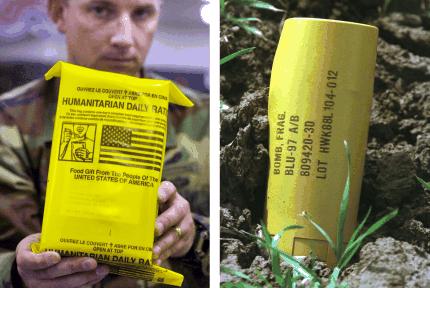
(Above: A cluster bomb from the 1960's. Below: A map of the locations where cluster bombs have been found in South Lebanon)
in Afghanistan
Food aid package and cluster bombs
Israel is being investigated by its fellow ally’s State Department for the illegal use of American-made cluster bombs on south Lebanon. Apparently Israel not only violated the Geneva Convention for using cluster bombs on civilian areas but also secret agreements with the United States that restricts when it can employ such weapons. According to the New York Times, the investigation by the department’s Office of Defense Trade Controls began this week, after reports that three types of American cluster munitions, anti-personnel weapons that spray bomblets over a wide area, have been found in many areas of southern Lebanon and were responsible for civilian casualties, even till today.
The agreements that govern Israel’s use of American cluster munitions go back to the 1970’s, when the first sales of the weapons occurred, but the details of them have never been publicly confirmed. The first one was signed in 1976 and later reaffirmed in 1978 after an Israeli incursion into Lebanon. News accounts over the years have said that they require that the munitions be used only against organized Arab armies and clearly defined military targets under conditions similar to the Arab-Israeli wars of 1967 and 1973.
A Congressional investigation after Israel’s 1982 invasion of Lebanon found that Israel had used the weapons against civilian areas in violation of the agreements. In response, the Reagan administration imposed a six-year ban on further sales of cluster weapons to Israel.
A report released Wednesday by the United Nations Mine Action Coordination Center, which has personnel in Lebanon searching for unexploded ordnance, said it had found unexploded bomblets, including hundreds of American types, in 249 locations south of the Litani River.
The report said American munitions found included 559 M-42’s, an anti-personnel bomblet used in 105-millimeter artillery shells; 663 M-77’s, a submunition found in M-26 rockets; and 5 BLU-63’s, a bomblet found in the CBU-26 cluster bomb. Also found were 608 M-85’s, an Israeli-made submunition.
The unexploded submunitions being found in Lebanon are probably only a fraction of the total number dropped. Cluster munitions can contain dozens or even hundreds of submunitions designed to explode as they scatter around a wide area. They are very effective against rocket-launcher units or ground troops.
In 1982, delivery of cluster-bomb shells to Israel was suspended a month after Israel invaded Lebanon after the Reagan administration determined that Israel “may” have used them against civilian areas. But the decision to impose what amounted to a indefinite moratorium was made under pressure from Congress, which conducted a long investigation of the issue. Israel and the United States reaffirmed restrictions on the use of cluster munitions in 1988, and the Reagan administration lifted the moratorium.
The use of these weapons is hotly opposed by many individuals and groups, such as the Red Cross, the NGO Cluster Munition Coalition and the United Nations, because of the high proportion of civilians that have fallen victim to the weapon. The particular threat this weapon poses to civilians exists for two main reasons. First, because of the weapon's very wide area of effect, accidentally striking both civilian and military objects in the target area is possible. The area affected by a single cluster munition, also known as the footprint, can be as large as two or three football fields. This characteristic of the weapon is particularly problematic for civilians when cluster munitions are used in or near populated areas and has been documented by research reports from groups such as Human Rights Watch and Landmine Action. Secondly, depending on type and their use, between 1% and 40% of the bomblets do not explode on impact. These unexploded ordnance (duds) present a particularly dense and dangerous form of post-conflict contamination and may unintentionally act like anti-personnel land mines (which have been banned in many countries under the Ottawa Treaty) for several years.
See more on cluster bombs here:
cluster bombs
cluster bomb cover
cluster bombs
Toys that kill children
Bombies
intellectual property rights: This blogger firmly believes in intellectual and other property rights. Links have been given to the material including images and maps used from outside sources. The blogger requests pointing out any material that have escaped this policy.
Today: consumption kills eco-systems; fraud, greed, grand larceny and theft bring down world's finances; deceit, infidelity and instant gratification destroy families; murders and wars have left us without peace or stability. On top we have droughts, earthquakes, floods, storms, tsunamis … has the world gone mad! Submit now to Allah before it is too late - to the One and Only God, the Creator, Lord and Sustainer of the universe, Unique in His Person and Actions, without any blemish, weakness or relatives. Follow the Sunnah of Muhammad (the last Messenger and Prophet - upon whom be the peace and blessings of Allah), and join those who will be the really successful ones.
Saturday, August 26, 2006
Toys that kill children
Subscribe to:
Post Comments (Atom)




















0 Comments:
Post a Comment